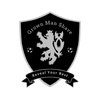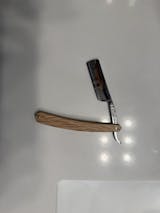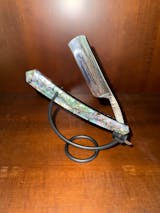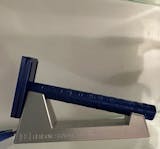Top Image © ClaudeAI.uk
Ask any experienced shaver and they will tell you mapping how your facial hair grows and knowing what your hair growth patterns are the first steps to elevating your wet shaving technique for a smoother shave.
The second part of the equation is choosing the right type of shaving tool that works best for your lifestyle and skin type. Regardless if it's a double-edge safety razor, straight razor, shaving soap, or shaving cream, the technique of knowing how your facial hair grows and its patterns will be a game changer and deliver an irritation-free, clean shave without razor bumps, burns, and ingrown hairs.
The Technical Art Of Wet Shaving

Today’s hustle culture makes most men complacent with the most convenient shaving tools and techniques. Relearning the art of traditional shaving is the key to having a baby butt smooth shaving—and it all starts with face mapping.
The history of straight razor shaving and wet shaving can be traced back to ancient times, well before modern safety razors, electric clippers, and cartridge razor systems with built-in lubricant strips. During the heyday of traditional shaving, it was a cardinal sin to use a shaving instrument on dry and unprepped skin without creams or soaps. This is the reason why in the past, barbers were likewise the local surgeon and the only ones trusted to offer a great shave and traditional grooming.
The technical art of wet shaving at home is merely a modern advent, as a modern gentleman and a participant in the resurgence of traditional shaving. To elevate our techniques, we must look to the past and study the inner workings of a shave for better results.
Needless to say, shaving is more than just using your razor on wet skin and hair. The art of shaving for a smooth shave is a holistic step-by-step process that starts with an excellent traditional razor and a rich, luxurious lather to help the blade glide seamlessly while achieving a skin-level shave—which you cannot get with just water. Don't worry guys, this is gonna be fun!
Here’s how wet shaving routine works:
- If you are using a straight razor, hone and strop first. If not, skip this part...
- Prepare your facial hair or beard and skin by using a warm towel or taking a warm shower...
- Apply pre-shave oil or pre-shave cream to prevent the skin from dehydration under prolonged water exposure...
- Bloom your shaving soap with your shaving brush with a small amount of water to get the lather hydrated...
- Put warm water inside the bottom chamber of your scuttle if you are using one, or prep the shaving bowl by rinsing it with warm water...
- Whisk vigorously until you reach your desired lather consistency. A good way to test the hydration of your soap or cream is the suction method, in which pressing the brush against your face with the lather and slightly lifting the brush produces a suction cup effect. This means your lather is perfectly hydrated. Of course, you may add more water if preferred...
- Apply the lather evenly on all areas you will shave; mapping the face will come afterward...
- Shave your facial hair while following the map of how your hair grows on your face and repeat the process as needed. Multiple passes are fine; just make sure to use the lightest pressure on the skin...
- Rinse and clean the lather and hair debris off the razor blade after each pass...
- Rinse your face...
- Apply your post-shave care and hydration to cool and soothe your skin from any irritation.
Determining Facial Hair Growth
Your beard grows according to the specific area on the face, wherein it follows particular hair growth patterns that will determine your shaving directions. The growth starts in the upper lip area, followed by the sideburns, chin, cheeks, and neck. Some facial hair growth will be upwards, downwards, or in a circular crop-like pattern.
How your facial hair and beard grows determines your facial hair grain, which is unique to you. A gentleman’s facial grain and hair growth patterns are determined during the beginning of the beard growth stages. Start with letting your facial hair grow from stubble and watch how each strand grows on your face in each section.
But not everyone has a keen, sharp eye and patience to check each strand of facial hair. If that seems challenging, here are more crafty ways to find out how hairs grow.

The Playing Card Method
Slide a playing card or any similar to a credit card on your skin with the most gentle pressure. Find the direction of your facial hair that does not shake or give any audible feedback chatter, and follow that as the direction of your hair grain.

The Cotton Ball Method
This is quite simple. Simply run a cotton ball down the pattern of facial hair growth. If it gets stuck, you’re going against the grain. If the cotton ball runs smoothly, then you're going with the grain, and that is your directional map.
Shaving With The Grain Vs. Against The Grain Vs. Across The Grain
Now that you found your grain pattern, the next challenge is whether you should shave with the grain or against the grain or across the grain. Every man’s beard is unique, so there is no absolute rule. Even the most experienced shavers still have to come up with a final answer. Truthfully, it’s a personal choice. The debate is that shaving against the grain causes more irritation by pulling the hair follicle up and away from the skin, so if you have thin skin or sensitive skin, always shave with the grain. But note that even experienced shavers are still to come up with a final answer. So, crossing this hurdle can take quite some time.
To get you on the right path, here are the different directions of shaving:
- Shaving with the grain (WTG) - shaving while following the direction of hair growth.
- Shaving against the grain (ATG) - shaving in the opposite direction of hair growth.
- Shaving across the grain (XTG) - shaving at a 90° angle while shaving WTG or ATG.
Each strand of your beard grows differently in different areas of your face. So, it is not wise to follow a single shaving direction for your cheeks, chin, neck, and around your mouth. You need to map your face, follow grain passes, and shave in the direction of growth, so your shaving instrument works efficiently.
Once you know the grain of your facial hair, you can proceed to face mapping....
Here is how to map your face and beard grain before shaving

- Create a lather using your shaving soap with a brush. Make sure it is thick to make the succeeding process easier...
- Apply the lather on the face evenly and generously using a circular motion...
- Lay a guideline where you can easily see it. Create lines across your face following the guideline using your fingers to divide each area...
- Draw up and down and left and right arrows to know which shaving direction you will use for each section.
Although shaving against the grain may seem like the best way to get a close shave at skin level, it is not advisable to do it at the first pass because it is more aggressive and can result in irritation and razor burn. Instead, start shaving in the same direction that your hair grows and progress to a more aggressive grain pass (WTG, ATG, XTG) to shave the leftover stubbles.
The shorter stubbles will be easier for the blade to cut than coarse hair. In turn, there will be fewer irritations on the skin and lessen the risk for razor burn, bumps, and ingrown hairs no matter what razor you use.
How Many Passes: Single Pass A Second Pass or multiple passes
Most shavers and beginner shavers tend to think that the more they shave on a particular spot, the smoother the shave will be. Hello razor burn! But as you grow older and gain more understanding of what triggers your post-shave irritations, you start to wonder: how many passes is enough?
With that, when it comes to shaving, is a single pass better than two or multiple passes?
If you are shaving your facial hair with the grain, you will definitely need a second or third pass and, if preferred, against the grain to ensure there are no leftover stubbles. However, you can get away with a single pass if you have a high-quality straight razor, shavette, or even an aggressive safety razor with a fresh razor-sharp blade. Still, the rule of thumb is not to go beyond three.
Wet Shave Vs. Dry Shave
Everyone dreams of a quick and irritation-free shave. Modern technology may have tricked men into thinking that it is possible to simply shave and go without facing any post-shave consequences. However, unless we live in a utopian reality, those two would not just work.
The secret to things that last and stay in their prime is to keep them well-taken care of. The same goes for your skin. Remember that razor blades are sharp, and shaving on unprotected skin will obviously result in nasty problems.
Wet shaving is always best if you are after a smooth and close shave. All the preparatory processes, like covering the face with a hot towel, applying pre-shave oil, and lathering, help moisturize and keep the skin and beard nourished. It makes the razor glide cleanly and smoothly, reducing blade-to-skin friction and resulting in an irritation-free shave and minimization of razor burn.
To Bow Down Or Yield: How Much Pressure Should You Apply When Shaving
More pressure does not always mean getting a closer shave—it all depends on your razor and technique. So, do know when to bow down or yield when shaving to protect your skin and prevent irritations.
Again, safety razors come in different aggressiveness. If you are after a mild shave, it would be best to use an adjustable or a closed-comb safety razor. The adjustable design will let you determine the aggressiveness of your razor, while the closed-comb design covers more of the blade’s edge to provide a milder shave. Otherwise, opt for an open comb DE razor.
For straight razor and Shavette users, it would be best to let the razor do the work. Remember, you are using a cutthroat blade with an overly-exposed edge. One simple mistake could lead to a bloody mess. Hence, use light pressure when shaving with a traditional single-edge blade and let gravity and the razor’s heft determine how light-handed you should be.
Straight Razor Vs. Safety Razor Vs. Cartridge Razor

Mastering the art of shaving starts with the kind of tool you use. You can opt for a straight razor if you are feeling traditional or go for more familiar options, like the safety razor and cartridge razor.
Straight Razor
A straight razor is the pioneer of all wet shaving tools. It has a classic single-edge blade attached to a handle through a pivot pin, which accounts for the razor’s defining pivoted mechanism wherein the blade closes into the handle when idle.
Straight razor blades are made from high-quality moisture and water-resistant materials, like stainless, high carbon, and Damascus steel. These razors are built to last. They are knives, after all. Therefore, they are sustainable and can be sharpened or honed once dull.
Safety Razor
Safety razors follow a more modern design using disposable double-edge blades that are economical and environmentally friendly. Did you know that all the plastic ever created still exists today? This is why safety razors are making a big comeback.
Modern double-edge safety razors come in several different styles: Fully-adjustable design with a dial or two or three-piece design with the basic parts: the top, handle, and base, wherein all parts can be disassembled from each other. These designs determine how the user will change the blade and the razor’s aggressiveness.
Cartridge Razor
On the other hand, cartridge razors have fully detachable heads housing more than a single blade. It requires men to throw the cartridge when the blades get dull and replace it with a new set. However, some users have found it more expensive to replace the head than buy a new cartridge razor, defeating the design’s overall purpose.
Cartridge razors are best known for their multiple-blade design, which Gillette first introduced. The most common cartridge razors have at least two to three blades. These were marketed to the masses as the secret to getting a close shave, wherein the first layer of blade lifts the hair off the skin, and the succeeding blades cut it.
Your Wet Shaving Checklist
Now that you’ve got the basics down and all the precautions needed, you are ready to complete your set of shaving gear. Here’s a checklist of all the tools you will need to achieve a barber-like experience at home:
- Pre-shave oil - plant-based carrier oil with essential oils
- Shaving soap - cold-pressed soap with natural high-fat content and low-alkalinity
- Scuttle or shaving mug - ceramic/steel/porcelain mugs with great heat-retention properties
- Shaving brush - traditionally comes with a wooden handle and stiff animal hair bristles
- Razor - single-bladed razors, like straight razors, shavettes, and safety razors
- Aftershave - moisturizing antiseptics to prevent and treat post-shave irritations
Pre-Shave Oil

Applying a layer of pre-shave oil will prevent your skin from drying out. The oil will keep the surface moisturized and nourished while providing an added layer of protection against an aggressive razor. It also helps moisten the dry, flaky skin, preventing them from clogging your razor for a smoother shaving experience.
Shaving Soap

Scuttle or Shaving Mug or Shaving Bowl

Shaving mugs look similar to a normal bowl you see in the kitchen. The defining difference is that it is molded to fit most shave pucks using ceramic, porcelain, or other similar materials with excellent heat-retention properties.
On the other hand, a scuttle is a two-chambered shaving mug, similarly crafted using the same materials but with a cork or plastic stopper to keep the hot water warm. The upper chamber is for creating and holding the lather and the bottom chamber is for housing hot water that will keep your lather warm—the very essence of a barber-like shave.
Shaving Brush

You cannot lather a shave soap without a brush, hence the importance of adding a shaving brush to your shaving kit. Although you can try lathering with your hands, we doubt that will give you great and even results.
Shaving brushes have four major bristles: badger, boar, horse, and synthetic. The natural animal bristles are graded depending on their manufacturing and sourcing processes. The brushes’ qualities are also defined by their loft, knot, and overall height, whereas larger brushes offer more coverage, while smaller brushes guarantee more precision.
Razor

Wet shaving works well with traditional single-blade razors, like straight razors, shavettes, and safety razors. Their designs and blade quality account for close and smooth skin-level shaving results in few passes. The faster and more efficient they get the job done, the less irritation appears after shaving.
Post Shave Ritual
Whether dry shaving or wet shaving, aftershave is a must-have product that should never go missing in your grooming kit. Aftershaves are the secret ingredient and are often the first-aid solution to preventing and treating post-shave skin irritations, like razor burn and bumps. These products could either be in the form of a lightweight splash, cologne, lotion, or a rich balm.
The natural antimicrobial and astringent properties calm down inflamed skin and kill off any bacteria that can cause major infections to the open micro-abrasions on the skin. Splash and colognes are excellent for mild hydration on sensitive to normal skin types after shaving. At the same time, thicker formulations like lotions and balms are perfect for dry skin that need extra nourishment.
As men, investing in a whole grooming kit may seem like a tedious thing to do. But if you are tired of nasty and bumpy-looking skin after shaving, then ensure you have all of these wet shaving essentials on your counter.
Triage
For severe cases of razor burn or simply to cool your face, I highly recommend a trusty alum block. Used for thousands of years for many different purposes, the alum block is a shaver’s best friend. For those nasty nicks and cuts, nothing works better than a styptic pencil.
The Key Takeaways
There is no better way to get a smooth shave without trouble than following the art of wet shaving. It may take some learning curve and a slower routine, but it will be worth it when you get a baby butt smooth shave.
Traditional and single-blade razors like straight razors, shavettes, and safety razors are your best companions in your wet shaving journey. Unlike modern plastic and disposable razors with multiple blades, these shaving tools can last for generations, making them a perfect family heirloom when well taken care of.
Do not forget your pre-shave ritual, especially mapping the face—unless you get to the level of an expert shaver. As a beginner, this will guide you into the best shaving direction ideal for your beard growth or facial hair grain.















